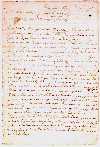 |
Annotation in the text of Canto de alegría in Malaspina's journal relating to the relationship with Macuina in Nootka (jpeg file 272 kb) |
3. Discourse as an ideological postulate
Written discourse is a basic element in the elaboration of the Western colonial concept. But, as in almost all of its ideological elements, it is not free of profound contradictions (Bancel and Blanchard 1997: 7). Discourse on people, their cultures and music not only depends, among other factors, on human subjectivity and contextual conditioning during "fieldwork", but also on the ethnographers' preconceptions when they began the task, the transformation they cause, their own political evolution during the time they spent away from their home country and, more especially, on their relationship to their potential readers.
Unquestionably, the wide historical time span considered here, specifically centered on 16th century conquerors and humanists and 18th century scholars, takes into account multiple epistemologies. Nevertheless major differences within this period appear not as a result of some evolutionary process, but in matters relating to the peculiar circumstances and intentions affecting research. My interest in considering this period as a whole resides precisely in our being able to set specific attitudes against a general discursive background, one that seems to spill over the conventional borderlines that mark the beginning contemporary Western history.
One can consider the following annotation as an example of one of the attitudes we may find among researchers:
 |
Annotation in the text of Canto de alegría in Malaspina's journal relating to the relationship with Macuina in Nootka (jpeg file 272 kb) |
"When the time to close the establishment came, he [the chief] was offered the house that was being built, and the rest was to be distributed to the other chiefs. Macuina [Maquina] reciprocated by giving assurances of his friendship that was another way of saying that the Spanish would always be the owners of the location they were occupying on that day, singing repeatedly the following song" (Tova Arredondo, 1791, b) (15).
When French members of La Perouse's voyage arrived in 1786 at Lituya Bay on the coast of Alaska, their journal enthusiastically records the musical sung or danced events organized around them. In a study comparing La Perouse's version of the encounter with that of the native Tlingit people, Mary Jane Lenz shows that the latter made no reference to the ceremonial aspects of the encounter (1989: 134) in which La Perouse (according to his own account) accepted the offer to buy Cenotaph Island. During Malaspina's stay in Nootka in 1791 and among the incidents that brought Britain and Spain on the verge of war, there is no question of purchase, or of taking possession by the Spanish party. One cannot fail to be struck, however, by the deep silence surrounding, in the various versions of the voyagers' account, the description of the musical exchange logged in the journals, such as the promise of chief Macuina to the Spanish of the "location they were occupying", and the song performed on the occasion. Macuina was described as a man of "a shy and suspicious disposition", who had excused his lack of interest in meeting the Spanish and his displeasure on account of having to move his household to Tasis. His song is entered in more than one of the Westerns versions (!) (16).
What is missing in journals, stories, and memoires that would make comprehensible to us their message today? Asking questions the text does not suggest (Booth 1979: 243) or recognizing the silences latent in the stories may be a valuable means of identifying the real intent of discourse around music. Why do 18th century scholars concern themselves with recording Macuina's song, while they systematically avoided gathering of data during the rest of their voyage? Or, beyond this particular case, why are the descriptions of musical practices so abundant and irregular among scholars and practically nil among conquerors? Could this perhaps be suitably explained by the Enlightenment mode of thought? Why is it that they are both interested in the interpretation of the significance of the events they witness, while they exhibit little curiosity about its transformations? Why do Dominican friars, on the contrary, take an interest in the ceremonial past of the American Indians, making comparisons with the significance of these musics in their own time? The "non-dit" of the discourse gets us back to the interpretation of the context. The historical circumstances in which their attitudes developed do not contribute to the construction of the imagery of a historical evolutionism, but to the realization of their own relativity.
With both progress and regression during the 18th century, as a result of the negative experience of its overseas undertakings and for the economic collapse of the Spanish crown, many in Europe became increasingly convinced that colonization at large scale, as in the Americas, was becoming a costly enterprise for the sponsoring nations. The issue became one of following the Phoenicians' example and not that of Columbus. In other words, they had to replace their policy of conquest by a commercial one.
|
The attitude towards the natives had
therefore to be changed, at least as far as the rules of
conquest were concerned. The instructions of the voyagers
were to try as far as possible to avoid confrontations
that could jeopardize the enterprise. Besides the
evaluation of the natural resources of the land - a task
that the naturalists embraced enthusiastically - they
also started compiling vocabularies and other cultural
data on its inhabitants that might be used in various
ways in the future. |
As regards Spain specifically, other
goals were to be added: control by the state of its old
colonies (one cannot forget that this is the time of the
famous Tupac Amaru insurrections), and the claim to the
right to commercial hegemony in geographic areas close to
former settlements, according to the new principle of the
'cultural unit'. |
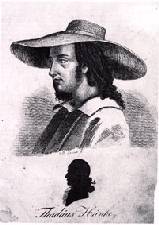 Portrait of Thadeus Haenke |
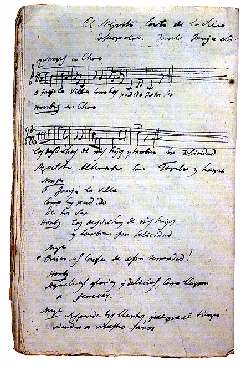 Haenke, El negrito casto de la Sierra |
In addition, these vocabularies served
in various circumstances to justify prior Spanish claims
to colonial control before those of other European
powers. In the case of the inhabitants of the Pacific,
the Philippine Islands were put forward as a unified
cultural dissemination center for these populations, in
opposition to James Cook's thesis, which defended the
idea of numerous mother tongues (Bustamante 1989: 84).
According to Enlightenment theories on the origin of
languages, song, rhythm, verse, and word have no
boundaries, allowing Cevallos to conclude his analysis by
emphasizing certain connections between the songs
collected in the Friendship Archipelago with Spanish
medieval metrics (18)
(Cevallos: 1793). Comparisons with the mother country may, however, have more than one interpretation. The comparative method is not to be found amongst authors who deny the encountered peoples any cultural value, while it is employed specifically amongst those who attempt to produce in the Spanish reader some kind of familiarity with these other cultures by comparing the local people's ways and customs to those of the mother country. |
The undertaking is not new, even among humanists such as Sahagún (19) or mestizos such as Garcilaso de la Vega, el Inca (20). Significantly, and for these very reasons, it is hardly ever to be found among the first 16th century conquerors.
"One day, during a gathering with English and natives, Quicomashia heard seguidilla songs and once these were over he asked about their theme: I replied that the absence of a lady. In turn other Spanish and English men sung their ballads and the encounter concluded with a most beautiful "anacreontica" performed by a young Irish man; the Thais asked me about the meaning of the piece. The first two only tell about love - I answered - and the one you just heard is an eulogy to wine. To this he replied: Don't the Spanish and the English have a god ... ? Thais of Nootka only sings to praise Quautz and ask for his help" (Moziño: 1791). (21)
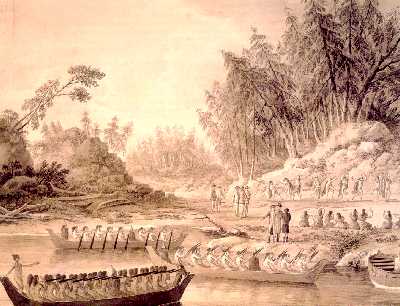 |
|
| Suria, Baile en la Playa de Nutka |
The friars belonging to the humanista school (represented in Spain mainly by the school of Salamanca) tried to censure the brutality of the conquest and used comparison as an impartial and 'unprejudiced' method of forwarding particular causes. "Before the wars they celebrated their festivals in freedom, large villages gathered in three or four thousands and more to dance. After the conquest, only half, and this number went on declining and lessening." (Benavente 1971: 383). "They used golden bells, which are now the same, only made of wood. They used tortoise-shaped shells made of gold to play on; now, they use the natural shell of the tortoise" (Sahagún 1990: 573) (22).
The acculturationist and assimilationist perspectives upon which Bernardino de Sahagún and other religious humanists imbued with the theories of the "right of the people" at the school of Salamanca in the 16th century based their studies, served more ambitious goals. The detailed richness of Sahagún's 'accounts-inventions' of the ritual festivals in the territories of New Spain; his interest in dignifying with precise data their past and present musical practices; his care to isolate the natural goodness of the Indian from his acts of idolatry; the harshness of his narrative when referring to the most bloody episodes of the conquest; and his decision to have this material published both in Castilian and Nahuatl languages - an exercise rarely repeated and often replaced by what Malinowski called the "active hunter who drives the prey into the trap and who chases it into its most inaccessible lairs" (1995: 26) - brings us to another goal of colonial research. This was a utopian politico-religious project: the creation of an Indian Republic, autonomous yet formally tied to the Crown, and effectively ruled by Franciscan friars and by Mexican officers chosen from a number of native civil servants. The investigation of pre-Columbine culture was for them, just as for the neo-Spanish historians they instructed in their classrooms, a means of dignifying the past, justifying their self-governing capacity and officially integrating both cultures.
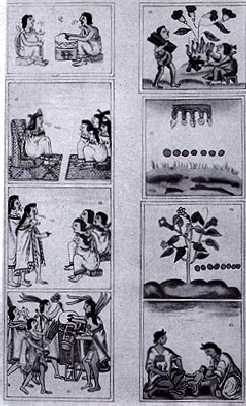 Sahagún, Flower: symbol of musicians and dancers |
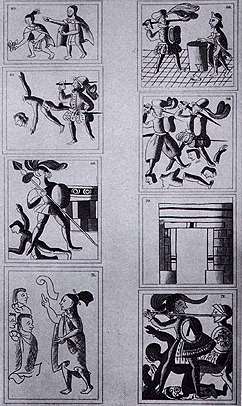 Sahagún, Slaughter of Indians during the festival of Uitzilopuchtli (..."And those who were playing had their hands cut off...") |
In the idiom of the missionaries, who conquered the lands of the Americas with their music (Turrent 1993), the musical expression of the Indian only exists in subordination to the project of a Christian empire. Their interest in the apprenticeship of the Indians and their pride in the results achieved was not capable of imagining other concerns or considerations apart from the dynamics of their setting: "I have heard that there is a teacher in Mexico who plays the "vihuela de arco", and they have made already the four voices and have started playing; I am sure that within a year the Indians will know as much if not more than their teacher"(Benavente 1971: 238) (23).
![]() Guaracha:
Convidando está la noche by Juan García de Zéspiedes (wav file 228 kb)
Guaracha:
Convidando está la noche by Juan García de Zéspiedes (wav file 228 kb)
Past and the present exist only as modulators of the future, the future of a New World that under Boecio's "virtus" (Pagden 1997: 46) would erase political, cultural and religious divisions in a united Christianity. Contradictory and fragile, this unstable thesis is obliged to integrate the figure of the "Other", deemed responsible for the chaos, to safeguard its own logic. The natives of the "Siècle des Lumières", whose musical manifestations are "guided only by instinct" (Didier 66), failed to endorse Enlightenment theories of "imitation" (24). English and Europeans in general elicit only defiance and insincere demonstrations of respect from the "natives". The flutes of the Indians of New Spain cannot be tuned under the Pythagorean fifth system, and the Spanish colonists teach the Indians 'indecorous' songs.
![]() El cañutero, New
Mexico (wav file 279 kb)
El cañutero, New
Mexico (wav file 279 kb)
The "ethnomusicological" discourse of the Modern Age allows us to appreciate the complex ways in which ideology obscures the obvious in particular contexts. Thus we must ask ourselves whether the musical behavior of the people described actually were the representation of a real 'other', or rather a static and imaginary discursive object onto which Europeans could project their intellectual, commercial and transformative power, in order to mark their own reciprocal political distance.